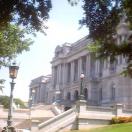Quote:

On February 14, 1884, Theodore Roosevelt rushed home to New York, having received news that his wife and mother were ill. When Roosevelt arrived, his mother had succumbed to typhoid, and his young wife was dying. The two women died within hours of each other. Roosevelt held his beloved wife in his arms as she died.
The normally wordy Roosevelt made but a single entry in his pocket diary that day: a large black X with the words, "The light has gone out of my life" beneath it. Afterwards, he rarely mentioned his wife. It was as if he were putting an event too painful to contemplate behind him.
For insight into the inner Roosevelt, historians rely on his private papers, over 250,000 of which are housed at the Library of Congress. On a recent visit, the pocket diary containing the above entry was on display in the exhibit on the second floor, in a glass case also containing diaries of Walt Whitman, Clara Barton, and George Patton. Elsewhere in the exhibit are documents from the Progressive Era: manuscripts by Ida R. Tarbell and other "muck-rakers", a charming photo of the Roosevelt children lining up for "roll call" at the White House, and newsreel footage of the Spanish-American war, the war that made T.R. an American icon.
T.R.’s personal hero was Abraham Lincoln, and numerous Lincoln artifacts are in evidence, including the contents of his pockets on the night he was assassinated. To walk through the exhibit is to walk through American history. Here is George Washington’s school copybook; there the first draft of the Emancipation Proclamation. Items are selected and rotated from the library’s 121,000,000-object collection.
"American Treasures" is divided into three parts: Memory, Reason, and Imagination, the organizing themes of Thomas Jefferson’s personal library. In truth I can scarcely do justice to this single exhibit at the Library of Congress, whose architectural and cultural glories are legion. By taking a narrower approach, tracking T.R., I soon realized that had I picked virtually any figure of importance in American history I would have been richly rewarded.
An interesting mental game to pursue at the exhibit was to find the T.R. connections. In the "Imagination" section a first edition of Owen Whister’s The Virginian is displayed. Roosevelt was a friend of Whister’s, and like him was an Eastern "dude" who went west, became a rancher, then came back East to write about – and romanticize – the life of the cowboy. Next to Whister’s book is a letter from Frederick Remington, whose paintings and sculptures did so much to establish the Wild West in the popular imagination. Remington, also a T.R. confederate, illustrated many of his books.
Noted for his prodigious reading habits, Roosevelt liberally exercised his presidential borrowing privileges at the Library of Congress. While he was a man of action, he was also one of our most intellectually accomplished presidents. "He was our kind," said Robert Frost. "He quoted poetry to me. He knew poetry."
From journals
Big Game Hunting in Washington, D.C.